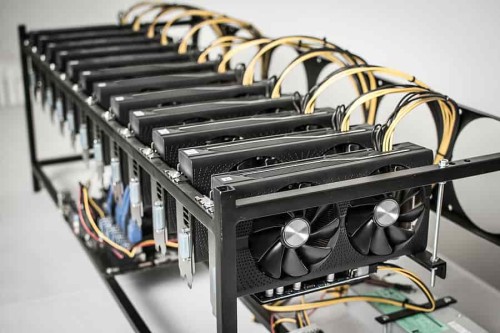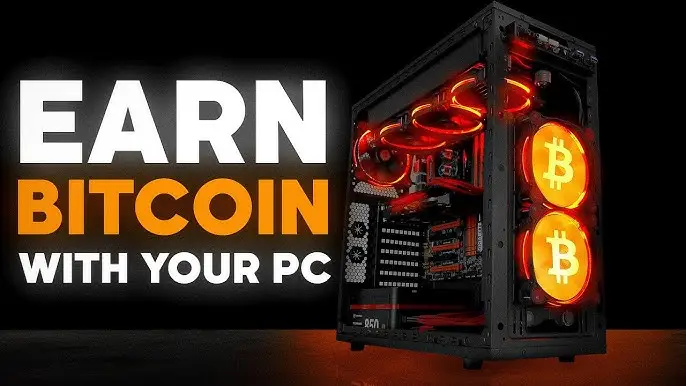To mine crypto with a PC at home, install mining software and join a mining pool. Optimize your PC’s performance and manage electricity costs.
Cryptocurrency mining at home can be a profitable venture if done correctly. Start by choosing the right cryptocurrency to mine, as some are more suited for PC mining than others. Install reputable mining software compatible with your hardware. Joining a mining pool increases your chances of earning rewards by combining your computational power with others.
Make sure your PC has adequate cooling to prevent overheating. Monitor electricity usage to ensure profitability. Regularly update your software for optimal performance and security. Mining requires dedication, but with the right approach, it can be a rewarding hobby or side income.

Introduction To Crypto Mining
Crypto mining uses your computer to solve complex math problems. These problems secure transactions on the blockchain. When a problem is solved, the miner earns cryptocurrency as a reward.
What Is Crypto Mining?
Crypto mining involves validating and adding transactions to the blockchain. It requires powerful computers to solve math problems. Successful miners get rewarded with new coins.
There are two main types of mining:
- Proof of Work (PoW)
- Proof of Stake (PoS)
Proof of Work is the most common method. It relies on computer power to solve problems. Proof of Stake relies on a person’s existing coins to validate transactions.
Why Mine Crypto At Home?
Mining crypto at home has several benefits:
- You can earn extra income.
- You have control over your mining setup.
- You can learn new technical skills.
Mining at home also allows you to choose which coins to mine. You can switch between different cryptocurrencies based on profitability.
Here is a simple comparison table:
| Aspect | Mining at Home | Cloud Mining |
|---|---|---|
| Control | High | Low |
| Cost | Initial setup cost | Ongoing subscription |
| Learning | High | Low |

Necessary Hardware
Mining cryptocurrency at home with a PC is possible. You need specific hardware for the best results. Choosing the right components is crucial. This section will guide you through the essential hardware needed.
Choosing The Right Pc
Start with a powerful PC. A strong CPU is essential. Aim for at least an Intel Core i5 or AMD Ryzen 5. More powerful CPUs will perform better. Ensure your PC has good cooling. Mining generates a lot of heat.
Graphic Cards For Mining
The graphic card, or GPU, is very important. NVIDIA and AMD GPUs are popular choices. The NVIDIA GeForce RTX 3080 is a top pick. The AMD Radeon RX 6800 XT is also a strong choice. Check the hash rate of each GPU. Higher hash rates mean better mining performance.
| GPU Model | Hash Rate | Power Consumption |
|---|---|---|
| NVIDIA GeForce RTX 3080 | 97 MH/s | 320W |
| AMD Radeon RX 6800 XT | 64 MH/s | 250W |
Power Supply Considerations
A good power supply unit (PSU) is crucial. It must support your GPU and CPU. Check the power requirements of your components. A PSU with at least 750W is often recommended. Make sure it has enough connections for your hardware.
- Check the power rating
- Ensure enough power connectors
- Look for high efficiency ratings
Using the right hardware can make mining easier. It will also improve your mining efficiency. Choose wisely to get the best returns.
Software Requirements
Mining crypto at home requires the right software. This software helps your PC solve complex algorithms. Let’s explore the essential software requirements.
Mining Software Options
Choosing the right mining software is crucial. Here are some popular options:
- CGMiner: Open-source and highly customizable.
- NiceHash: User-friendly with automatic optimization.
- Claymore: Great for dual mining, offers high performance.
- BFGMiner: Modular design, supports various algorithms.
Setting Up Mining Software
Follow these steps to set up your mining software:
- Download and install your chosen software.
- Create a crypto wallet for storing your earnings.
- Join a mining pool for better chances of rewards.
- Configure the software with your pool and wallet details.
- Start the software and begin mining.
Monitoring Tools
Monitoring tools help you track your mining performance. Here are some useful options:
- Awesome Miner: Offers remote monitoring and management.
- Minerstat: Provides detailed performance statistics.
- Hive OS: Excellent for managing multiple rigs.
- MultiMiner: Easy to use with automatic detection of mining devices.
Install these tools to keep an eye on your mining progress. They help you optimize and troubleshoot issues quickly.
Setting Up Your Mining Rig
Setting up a crypto mining rig at home can be exciting. You need the right hardware, software, and network setup. Follow these steps to get started with your mining adventure.
Assembling The Hardware
First, gather the necessary hardware. Here’s a list of what you need:
- Motherboard
- Graphics Cards (GPUs)
- Power Supply Unit (PSU)
- RAM
- Storage (SSD or HDD)
- Cooling System
- Risers for GPUs
Once you have all the parts, start assembling:
- Attach the motherboard to the frame.
- Install the CPU and RAM.
- Connect the power supply unit (PSU).
- Mount the GPUs using risers.
- Connect all necessary power cables to the GPUs.
- Install the cooling system to prevent overheating.
Installing The Software
After assembling the hardware, you need to install the right software. Follow these steps:
- Install an Operating System (OS). Windows or Linux are good options.
- Download and install GPU drivers from the manufacturer’s website.
- Install mining software. Popular choices include NiceHash and Claymore.
- Configure the mining software with your wallet address and pool information.
Ensure all software is up to date for better performance.
Network Configuration
Your mining rig needs a stable internet connection. Follow these steps:
- Connect your rig to the internet using an Ethernet cable.
- Set up a static IP address to avoid network conflicts.
- Ensure your router has port forwarding enabled for your mining software.
- Use a VPN for added security.
Check your connection speed to ensure it is fast and stable.
Choosing A Cryptocurrency
Deciding which cryptocurrency to mine is crucial. Not all coins are suitable for mining at home. Some require expensive hardware or consume too much electricity. Others may be unprofitable due to low value. Let’s explore popular options and profitability considerations.
Popular Cryptocurrencies
Many cryptocurrencies exist, but not all are ideal for home mining. Here are some popular choices:
- Bitcoin (BTC) – The first and most well-known cryptocurrency. It needs powerful hardware.
- Ethereum (ETH) – Popular for its smart contracts. Easier to mine with consumer GPUs.
- Litecoin (LTC) – Known as the silver to Bitcoin’s gold. Less demanding on hardware.
- Monero (XMR) – Focuses on privacy. Can be mined with CPUs, making it home-friendly.
- Zcash (ZEC) – Offers strong privacy features. Suitable for GPU mining.
Profitability Considerations
Mining profitability depends on several factors. Evaluate these aspects before choosing a coin:
- Hardware Costs – High-end GPUs can be expensive. Calculate initial investment.
- Electricity Costs – Mining consumes power. Check local electricity rates.
- Coin Value – Higher coin value may lead to higher profits. Track market prices.
- Mining Difficulty – Some coins become harder to mine over time. Research difficulty levels.
- Block Rewards – Rewards vary between coins. Higher rewards can mean better profits.
By carefully selecting a cryptocurrency, you can optimize your mining setup. This ensures better returns and efficient use of resources.
Mining Pools
Mining cryptocurrency at home with a PC can be challenging. Mining pools make it easier and more rewarding. By joining a mining pool, you combine your computing power with others. This increases your chances of earning rewards.
What Are Mining Pools?
Mining pools are groups of miners who work together. They share their processing power over a network. When a block is successfully mined, the reward is split among the pool members. This makes mining more consistent and less risky.
Joining A Mining Pool
Joining a mining pool is simple. Follow these steps:
- Choose a mining pool that suits your needs.
- Create an account on the pool’s website.
- Download mining software compatible with your PC.
- Configure the software with the pool’s server address and your account details.
Once set up, your PC will start mining as part of the pool. You will contribute to the pool’s efforts and earn a share of the rewards.
Pool Fees And Payouts
Mining pools often charge fees for their services. These fees cover maintenance and operational costs. Pool fees usually range from 1% to 3% of the rewards. It’s important to understand the fee structure before joining.
| Pool Name | Fee Percentage | Payout Frequency |
|---|---|---|
| Pool A | 1% | Daily |
| Pool B | 2% | Weekly |
| Pool C | 3% | Monthly |
Payouts vary based on the pool’s rules. Some pools pay daily, others weekly or monthly. Make sure to check the pool’s payout schedule. This helps you understand how often you will receive your earnings.
Joining a mining pool can make your crypto mining experience more rewarding. By understanding mining pools, joining a mining pool, and pool fees and payouts, you can maximize your earnings with your home PC.
Optimizing Your Setup
Optimizing your setup is crucial for efficient crypto mining at home. Making the most of your PC’s capabilities ensures better performance and higher profits. Let’s explore some key areas to focus on.
Overclocking Your Gpu
Overclocking your GPU can boost your mining performance. It involves running the GPU at a higher speed than the manufacturer’s settings.
- Download and install a reliable overclocking tool.
- Gradually increase the GPU clock speed.
- Monitor the system for stability and performance.
Be careful not to push your GPU too hard. This can cause overheating and damage.
Temperature Management
Proper temperature management keeps your PC running smoothly. High temperatures can lead to hardware failures.
- Use high-quality thermal paste on your CPU and GPU.
- Install additional cooling fans in your PC case.
- Ensure good airflow by keeping the PC in a well-ventilated area.
Regularly clean dust from fans and heat sinks. This helps maintain optimal temperatures.
Energy Efficiency
Energy efficiency is vital for reducing electricity costs. Use energy-efficient components whenever possible.
| Component | Energy-Efficient Alternatives |
|---|---|
| Power Supply Unit (PSU) | 80 PLUS certified PSU |
| GPU | Latest generation GPUs |
Turn off unnecessary background applications. This reduces overall power consumption.
Consider using a power meter to monitor energy use. This helps identify areas for improvement.
Security And Maintenance
Security and maintenance are crucial when mining crypto at home. Your PC needs to be protected from threats and maintained for optimal performance. This section will guide you through securing your wallet, regular maintenance tips, and protecting against malware.
Securing Your Wallet
Your crypto wallet holds your earnings. It’s essential to keep it secure.
- Use a strong, unique password for your wallet.
- Enable two-factor authentication (2FA) for added security.
- Store your wallet’s backup phrase offline in a safe place.
- Avoid sharing your private keys with anyone.
Regular Maintenance Tips
Regular maintenance ensures your PC runs smoothly while mining.
- Update your software regularly. This includes the operating system and mining software.
- Clean your PC to prevent dust buildup. Dust can overheat components.
- Check your PC’s cooling system. Make sure it’s working efficiently.
- Monitor your PC’s performance and adjust settings if needed.
Protecting Against Malware
Malware can steal your crypto or harm your PC. Take steps to protect against it.
- Install a reputable antivirus program. Keep it updated.
- Be cautious with email attachments and downloads. Only open trusted sources.
- Use a firewall to block unauthorized access to your PC.
- Regularly scan your PC for malware and remove any threats found.
Legal And Ethical Considerations
Legal and Ethical Considerations are crucial when mining crypto at home. Understanding these aspects ensures you stay compliant and act responsibly.
Legal Implications
Mining crypto at home involves navigating various legal regulations. Different countries have different rules. Some nations encourage crypto mining, while others restrict it.
Check local laws to see if mining is legal in your area. Violating these laws can lead to fines or other penalties. Always use legitimate mining software to avoid legal issues.
Ensure your electricity use does not breach local guidelines. High electricity consumption might attract scrutiny.
| Country | Legal Status | Regulatory Body |
|---|---|---|
| USA | Legal | SEC |
| China | Restricted | People’s Bank of China |
| Germany | Legal | BaFin |
Ethical Mining Practices
Ethical mining practices are important for the crypto community. Always use energy-efficient hardware to reduce your carbon footprint.
Consider using renewable energy sources like solar or wind power. This can make your mining more sustainable.
Avoid joining mining pools that engage in malicious activities. Such activities can harm the network and your reputation.
Ensure your mining activities do not disturb your neighbors. High noise levels and excessive heat can cause problems.
Practice transparency by sharing your mining methods and energy use. This helps build trust within the community.
- Use energy-efficient hardware
- Opt for renewable energy sources
- Avoid malicious mining pools
- Maintain low noise and heat levels
- Be transparent about your practices
Potential Challenges
Mining crypto with a PC at home can be exciting and profitable. But there are potential challenges that you should be aware of. Understanding these challenges can help you be better prepared and ensure a smoother mining experience.
Common Issues
Several issues can arise while mining crypto with a home PC. Here are some common problems:
- Overheating: Mining generates a lot of heat. This can cause your PC to overheat.
- Hardware Wear: Mining can wear down your hardware quickly.
- High Electricity Bills: Mining consumes a lot of electricity. This can increase your bills.
- Network Issues: A stable internet connection is crucial. Network issues can interrupt your mining.
- Software Bugs: Mining software can have bugs. These bugs can cause crashes or inefficiencies.
Troubleshooting Tips
Here are some tips to help you troubleshoot common mining issues:
- Monitor Temperature: Use software to monitor your PC’s temperature. Ensure it stays within safe limits.
- Improve Cooling: Invest in better cooling solutions like fans or liquid cooling systems.
- Check Power Supply: Make sure your power supply can handle the load. An underpowered supply can cause problems.
- Optimize Settings: Optimize your mining software settings for better performance and efficiency.
- Update Software: Regularly update your mining software. Updates can fix bugs and improve performance.
- Stable Internet: Ensure a stable and fast internet connection. Use a wired connection if possible.
- Regular Maintenance: Clean your PC regularly. Dust can cause overheating and hardware issues.
By understanding and addressing these challenges, you can have a more successful mining experience at home.
Future Of Home Crypto Mining
The future of home crypto mining looks promising. With advancements in technology, mining from home is becoming more accessible. Let’s explore what the future holds.
Trends To Watch
Several trends are shaping the future of home crypto mining. Here are some key ones:
- Energy-efficient hardware: New mining hardware uses less power.
- Decentralized mining pools: Mining pools are spreading out.
- Cloud mining services: More services offer mining in the cloud.
- Green mining: Efforts to make mining eco-friendly are increasing.
Long-term Viability
The long-term viability of home crypto mining depends on various factors:
- Electricity costs: Lower costs make mining more profitable.
- Hardware advancements: Better hardware makes mining easier.
- Regulatory environment: Friendly laws help miners operate.
- Market conditions: High crypto prices make mining attractive.
Home crypto mining can be a rewarding hobby. It might even become a viable income source. Stay updated with trends and advancements to succeed.

Frequently Asked Questions
Can I Use My Home Pc To Mine Crypto?
Yes, you can use your home PC to mine crypto. However, it may not be efficient or profitable.
How To Use Pc To Mine Crypto?
To mine crypto on a PC, install mining software like NiceHash. Choose a compatible cryptocurrency and configure settings. Ensure your hardware, especially GPU, is powerful and adequately cooled. Join a mining pool to increase profitability. Monitor performance and earnings regularly.
What Is The Easiest Crypto To Mine On Pc?
Monero (XMR) is the easiest crypto to mine on a PC. It uses CPU-friendly RandomX algorithm, making it accessible.
How Much Can You Make Mining Crypto With One Computer?
Earnings from mining crypto with one computer vary. Factors include hardware, electricity costs, and cryptocurrency value. Typically, profits range from a few cents to several dollars daily.
Conclusion
Mining crypto at home with a PC can be rewarding and educational. Start with the right hardware and software. Monitor your progress and adjust settings as needed. Remember, patience and persistence are key. With dedication, you can effectively mine crypto from the comfort of your home.
Happy mining!


